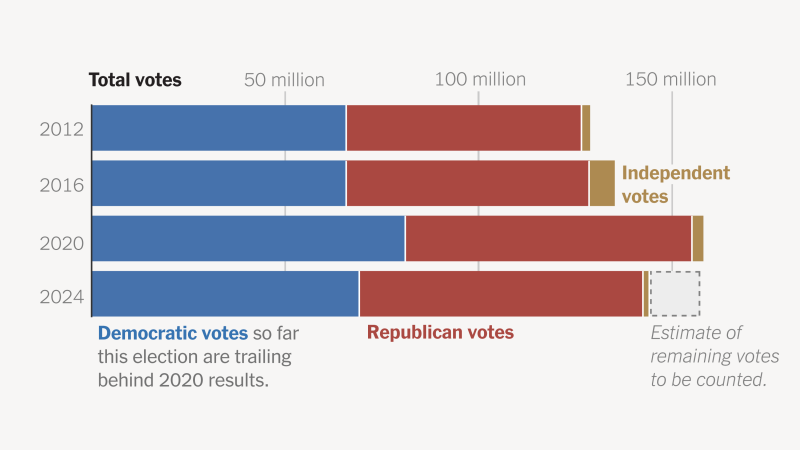Drop-Off in Democratic Votes Ignites Conspiracy Theories on Left and Right
By: Stuart A. Thompson (The New York Times)


There's nothing to see here. Really. No less authority than the unbiased liberal press has assured us that our eyes are lying. And the New York Times found a meme on social media to back up their abject dismissal of any questions.
Inevitable. No. But certainly expected. Democrats are grasping for anything to deflect attention away from their failures and patch up the bubble of urbane elitism.

Nov. 9, 2024 -- When President-elect Donald J. Trump was announced the winner of this year's presidential contest on Wednesday, the vote tallies initially suggested a sharp drop-off of millions of Democratic votes compared with the results in 2020.
To some Republicans, that slump was evidence that the 2020 election had been fraudulent, that Democrats had somehow conjured millions of phantom votes that year — despite repeated confirmation from election officials, statewide audits and courts that nothing nefarious had occurred.
The shortfall also set off doubts among the internet's left flank, but for different reasons. Hundreds of thousands of posts on social media implored Vice President Kamala Harris to avoid conceding over suspicions that millions of votes were somehow "missing" this year — despite assurances from federal agencies that the election was safe and secure.
Though it is unusual for opposing political camps to create conspiracy theories from the same material, supporters of both candidates have fixated on Democrats' underperformance this year as a central narrative. The conversation online highlights the appeal that election fraud stories have to partisans of all stripes — especially those facing electoral defeat — and the power of social media to help those ideas go viral, despite ample evidence that the concerns are meritless.
Though election officials dealt with a variety of complications on Election Day this year, Jen Easterly, the director of the Cybersecurity and Infrastructure Security Agency, concluded there was "no evidence of any malicious activity that had a material impact on the security or integrity of our election infrastructure."
As more ballots were counted in the days since, estimates from The Associated Press suggest that the number of votes cast this year will be about 157.6 million, down about 700,000 from 2020. The gap between Mr. Trump and Ms. Harris has continued to narrow as more votes are counted in left-leaning states like California, Washington and Oregon, which take time to process mail ballots.
The right-leaning version of the conspiracy theory was shared by towering figures in conservative commentary, while the left-leaning version came from voters with much less reach.
“I’ve never thought about it in this way, but when he lost in 2020 and I kind of — I thought there was something wrong with it,” Tucker Carlson, the Fox News host turned internet personality, said on an election night livestream that received three million views. “Now I’m totally convinced it was stolen.”
Another post shared on X by a far-right account with more than three million followers included a chart on turnout by party, which appeared to show Democratic turnout had doubled in 2020. But the chart used a manipulated axis and preliminary data to exaggerate the difference. The post was viewed nearly two million times.

The chart axis begins at 50 million, instead of zero, exaggerating the difference in votes for Democrats. As more votes were counted, the Democratic deficit also shrank considerably.
The theorizing from the left came from voices with far less prominence than Mr. Carlson, though their missives still earned millions of views on X, according to a report by Cyabra, a company that monitors disinformation. The company found that posts from profiles with few followers were able to reach tens of millions of views after posting about the conspiracy theory. Cyabra blamed the posts for “undermining trust in the 2024 election process and democratic institutions.”
Claims from the left have focused on interference from Russia or a number of bomb threats that were called into polling sites in swing states. Many also echoed claims that Trump supporters had made after the 2020 election, including suggestions that Ms. Harris’s large crowd sizes showed that Democratic enthusiasm was greater. Experts say crowd sizes are not a useful predictor of Election Day turnout.
The hashtag #DoNotConcedeKamala trended on X this week with more than 650,813 mentions by Friday, according to data from NewsGuard, a company that tracks misinformation. On Wednesday morning alone, there were more than 30,000 mentions of the hashtag along with the word “rigged,” “fraud” or “stolen,” NewsGuard found.
“If anyone could fund a massive election fraud scheme it’s Elon musk,” wrote Dean Obeidallah, a host of a show on SiriusXM’s Progress channel, to more than 50,000 followers on Threads. He called for the Department of Homeland Security to examine the results to “alleviate concerns that Trump and Elon Musk somehow cheated to win.” Mr. Musk, the owner of X, was a vocal Trump supporter. Mr. Obeidallah did not respond to a request for comment.
So far, fears among disinformation researchers that the clamor could build into a larger movement were tempered by Democratic leaders, who have widely endorsed the results — something that Mr. Trump and his allies refused to do in 2020.
Ms. Harris conceded the race in a speech Wednesday. The House minority leader, Hakeem Jeffries, said that Democrats would accept the results and that they “believe in free and fair elections.”





Look, the New York Times found a meme on social media to back up their excuses, delusions, and deflections. Yes, it is understandable that Democrats would prefer to talk about 2020 than 2024.
Democrats are returning to the past that Kamala Harris wanted to leave behind. Wasn't anyone giving attention to Kamala Harris? Maybe that provides some insight into 2024.
Harris got about 10 million less popular “votes” than Biden in 2020. Trump got about 1 million more in 2024 than 2020. One can draw their own conclusions about how that happened.
No gaslighting required.